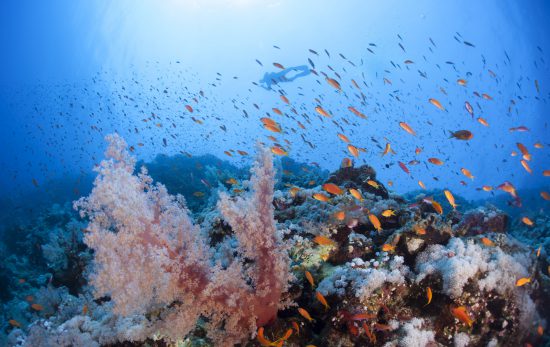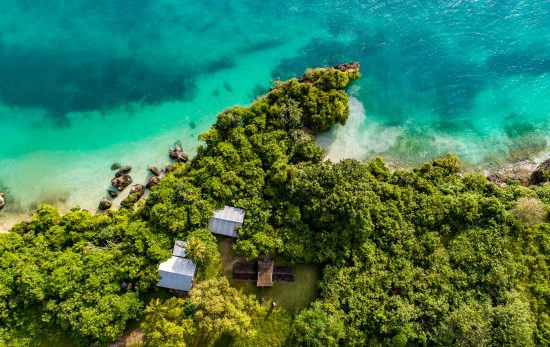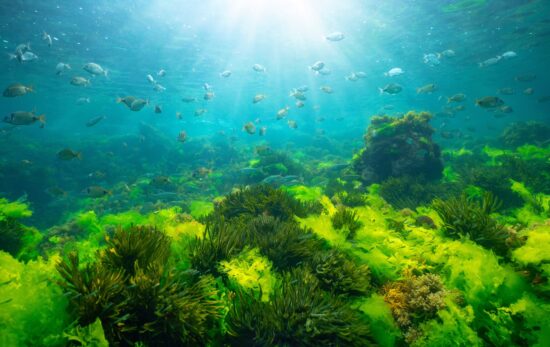Sea turtles are among the cutest animals populating our seas. It doesn’t come as a surprise that both divers and snorkelers are always very happy to spot them and swim with them. But, how much do we actually know about sea turtles? Read on and learn more about these amazing marine animals!
Sea turtles are reptiles (like crocodiles and snakes) that have existed for over 150 million years. That’s long enough to have seen the rise and the fall of dinosaurs.
As you’ve probably already guessed, sea turtles have adapted their bodies to live in the oceans. In fact, they spend about 96% of their lives at sea.
There are seven species of sea turtle world-wide:
- Leatherback Sea Turtle (Dermochelys coriacea)
- Loggerhead Sea Turtle (Caretta caretta)
- Green Sea Turtle (Chelonia mydas)
- Hawksbill Sea Turtle (Eretmochelys imbricata)
- Olive Ridley Sea Turtle (Lepidochelys olivacea)
- Flatback Sea Turtle (Natator depressus)
- Kemp’s Ridley Sea Turtle (Lepidochelys kempii)
Below, you’ll find a list of amazing places in the world to dive and swim with sea turtles in their natural habitats. Explore interacting and snorkeling with sea turtles here.
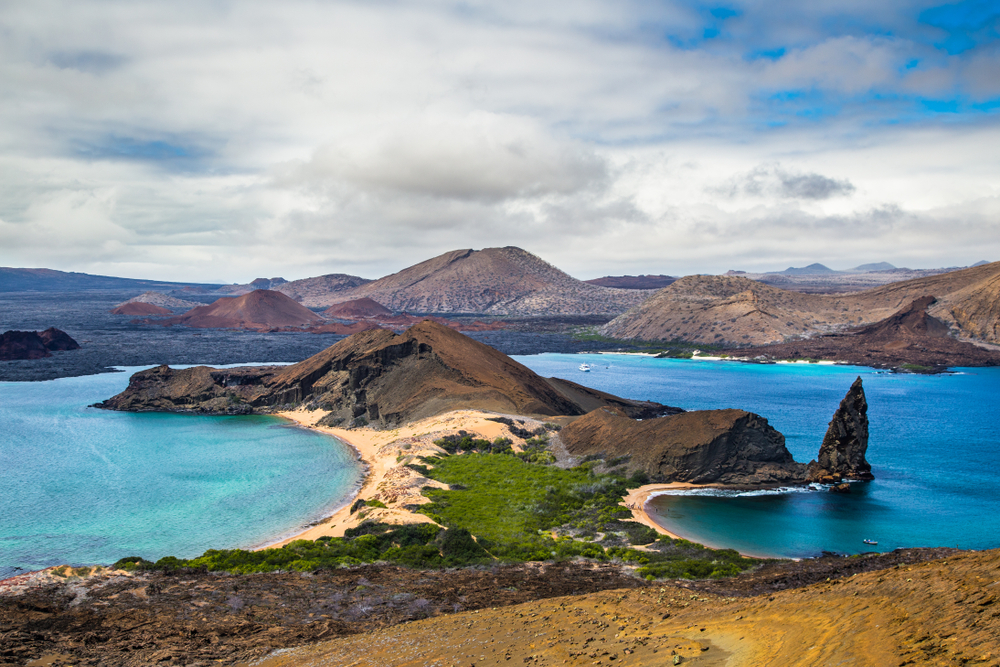
1. Galapagos Islands, Ecuador
The Galapagos green sea turtle (Chelonia mydas agassisi) is a subspecies of green turtle that can only be found nesting in the archipelago of the Galapagos. This subspecies inhabits the subtropical and tropical waters of the Pacific Ocean. It is distinguished from other green sea turtles by its serrated lower jaw and the single pair of scales covering its eyes.
These turtles can be seen while snorkeling and diving in the Galapagos all year long. The principle nesting site is Quinta Playa on Isabela Island.
- Best time: December to March
- Nesting season: December to March
- Hatching season: February to May
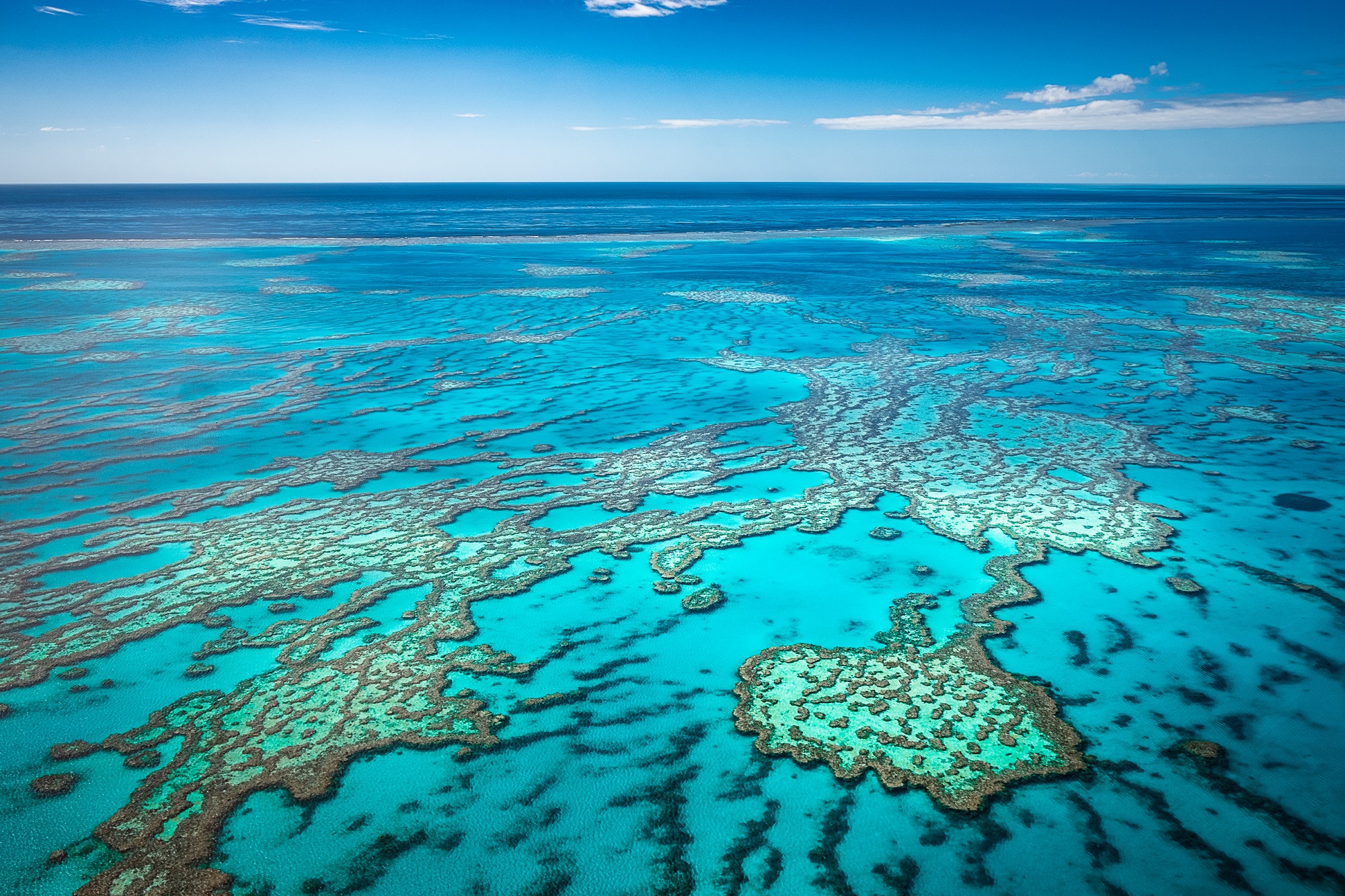
2. The Great Barrier Reef, Australia
The Great Barrier Reef is the largest coral reef system in the world. It extends for 1,200 miles (2,000km) and is even visible from space. Although it has been damaged by global warming and pollution, this marine formation is still rich in life, with more than 1,500 species of fish, several different species of whales, dolphins and six species of sea turtles.
The nesting sites of the green sea turtle are called rookeries. There are a total of 18 along the Great Barrier Reef. Five of them, with more or less 30,000 nesting females, are around Raine Island and Moulter Cay in the northern section of the Great Barrier Reef. The other 13 are in the southern section of the reef in a group of islands called Capricorn Bunker, where around 8,000 females go to lay their eggs.
- Best time: May to October
- Nesting season: Late October to February
- Hatching season: Late December to April
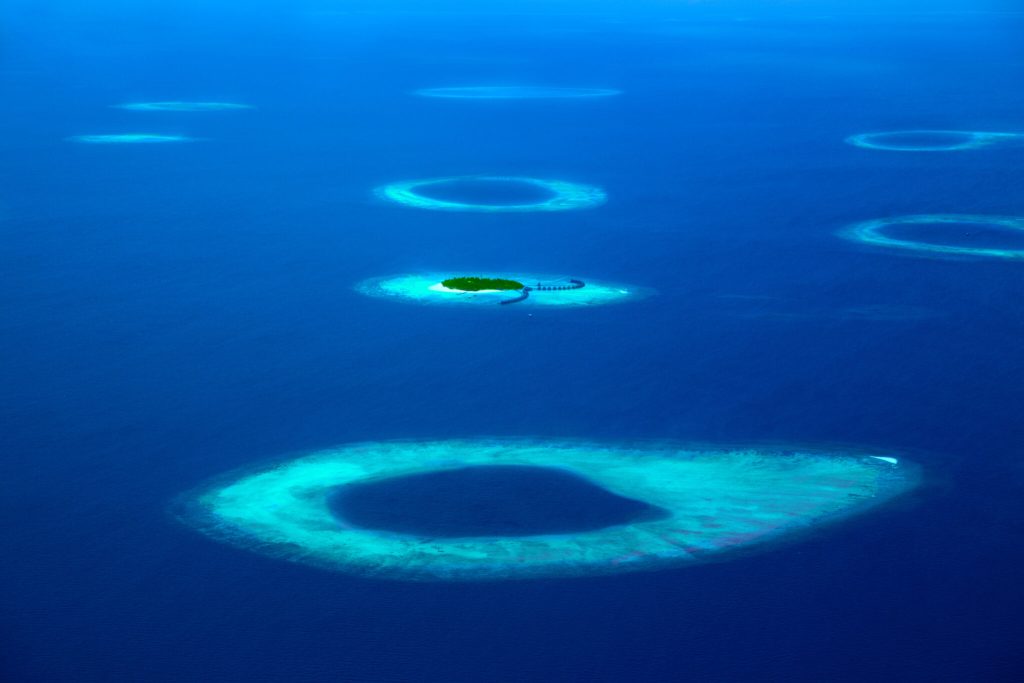
3. Ari Atoll, Maldives
The Maldives includes more than 1,000 coral islands divided into 26 ring-shaped atolls in the Indian Ocean. These atolls are famous for their white coral sand and their incredible marine life.
Diving and snorkeling in the Ari Atoll is unforgettable and appropriate even for beginners. You’ll be delighted by manta rays, schools of tropical fish, nudibranchs, starfish, dolphins and whale sharks.
Sea turtles are everywhere, even in the shallow water. You can easily see hawksbill turtles while they eat sea sponges along the reef (in the foraging area). Sometimes, it is possible to swim with olive ridley and green turtles. However, these turtles rarely lay their eggs in the Maldives.
- Best time: January to April
- Nesting season: Very rare
- Hatching season: Very rare
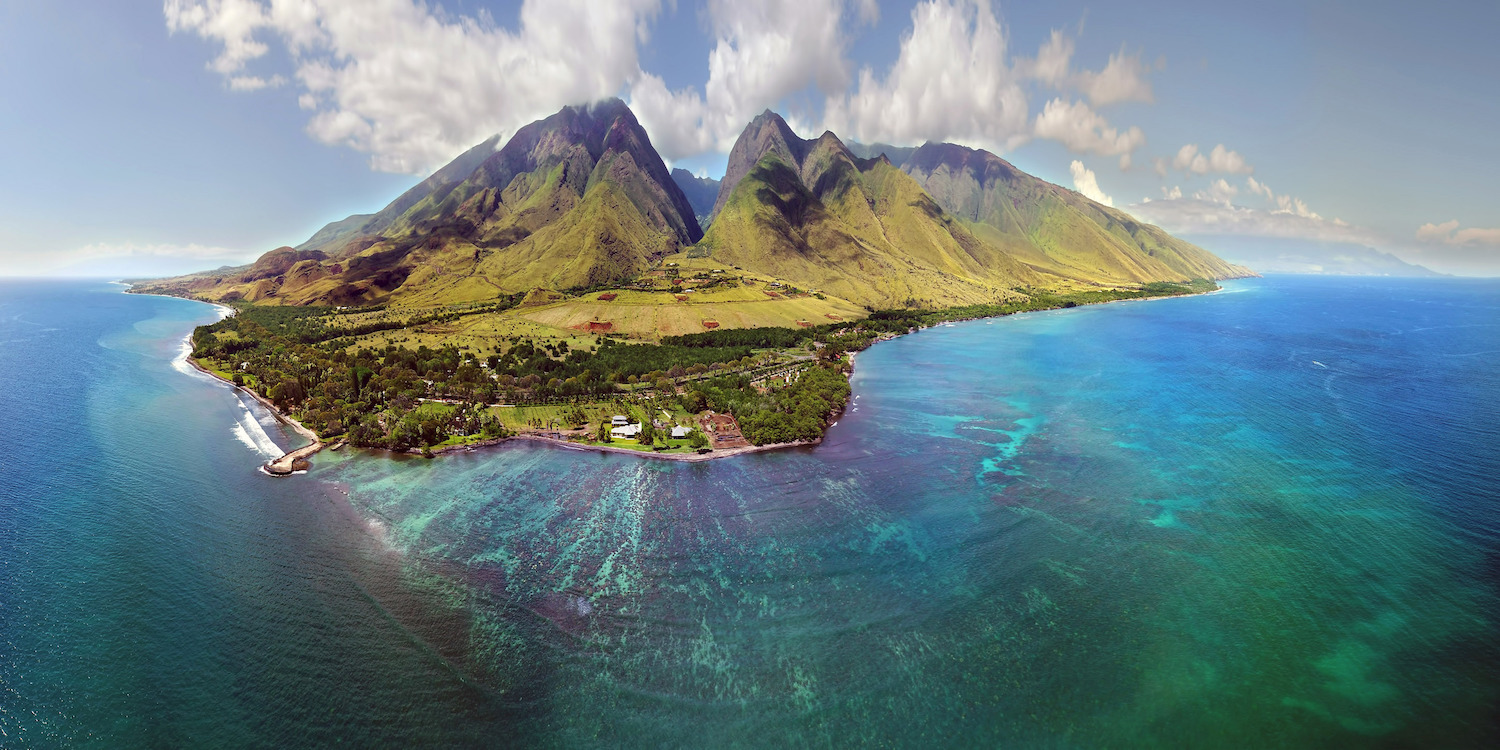
4. Maui Island, Hawaii
Hawaii is a volcanic archipelago in the central Pacific Ocean and is home to 5 of the 7 species of sea turtles. The most commonly seen are the green sea turtle (locally called honu) and the hawksbill (honu’ea). Less frequently seen are the leatherback, the loggerhead and the olive ridley.
Hawaiian green sea turtles are easily spotted year round while snorkeling or diving along the south and west coast of Maui, especially in front of South Maui Turtletown. You can see them feeding on algae, lying on the ocean floor or coming up to the surface to breathe. You might even spot one on the beach basking in the sun.
Keep in mind that you shouldn’t harass these turtles. First of all, harassment will disturb the turtles, but also harassment of turtles is illegal in the Hawaii.
- Best time: April to October
- Nesting season: Green sea turtles in the northwestern Hawaiian Islands nest in the Papahanaumokuakea Marine National Monument from May to October. 90% of hawksbill nesting activity has been recorded on the Ka’u coastline of Hawaii Island.
- Hatching season: Late June to December (hawksbill turtles)
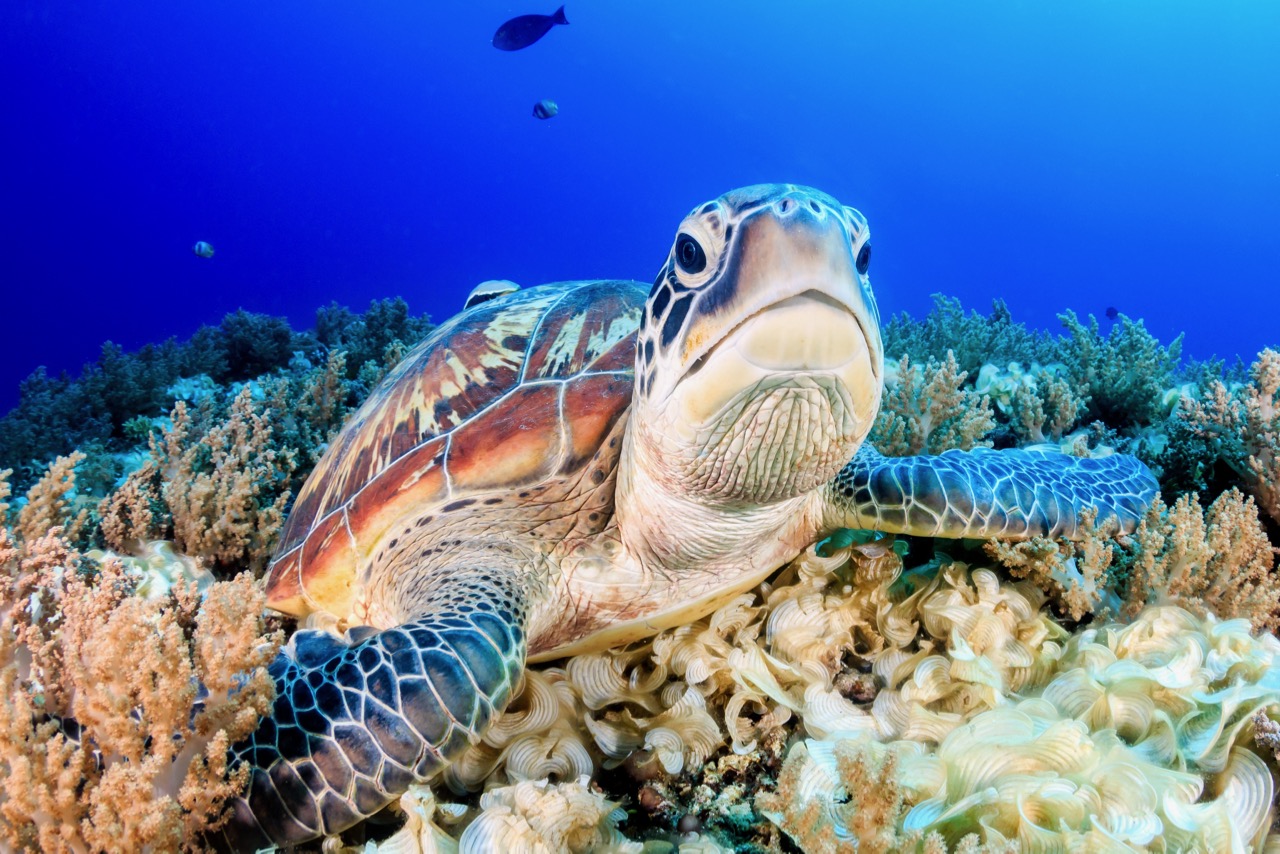
5. Marsa Alam, Egypt
Marsa Alam is a town in the southeastern part of Egypt and is one of the most famous dive destinations in the Red Sea. If you are looking for a stunning coral reef, tropical fish, dolphins, reef sharks, napoleon fish and especially sea turtles, this is the right destination for you.
Abu Dabbab Bay is widely known as a beautiful sandy beach where it is possible to swim with green sea turtles and dugongs. Both feed on seagrass and are usually seen while snorkeling not too far from the beach. If you are looking for hawksbill sea turtles, you should dive or snorkel along the reefs, where they frequently feed.
Both species rarely lay their eggs along the coast. Most nesting activities occur on offshore islands where land access is forbidden by law. Sometimes nesting season can start earlier or later than usual, depending on the temperature.
- Best time: June to September
- Nesting season: July to August
- Hatching season: August to October (green turtles); July to October (hawksbill turtles)
6. Sipadan, Malaysia
Sipadan is a very small island in Malaysia in the Celebes Sea and is one of the top dive destinations in the world with thousands of species of fish and hundreds of corals.
Here you can dive with large schools of barracuda, bigeye trevally, white tip sharks, nudibranchs and occasionally manta rays, hammerheads and whale sharks.
This place is also ideal for swimming with the green and hawksbill sea turtles that inhabit the reef all year round. You will be surrounded by them (seeing 20 to 30 per dive). They don’t mind divers, simply eating or coming up to the surface to breathe. Moreover, the water is always warm with a temperature of 26-30°C (79-86°F).
- Best time: April to November
- Nesting season: April to September (both species)
- Hatching season: June to November (both species)
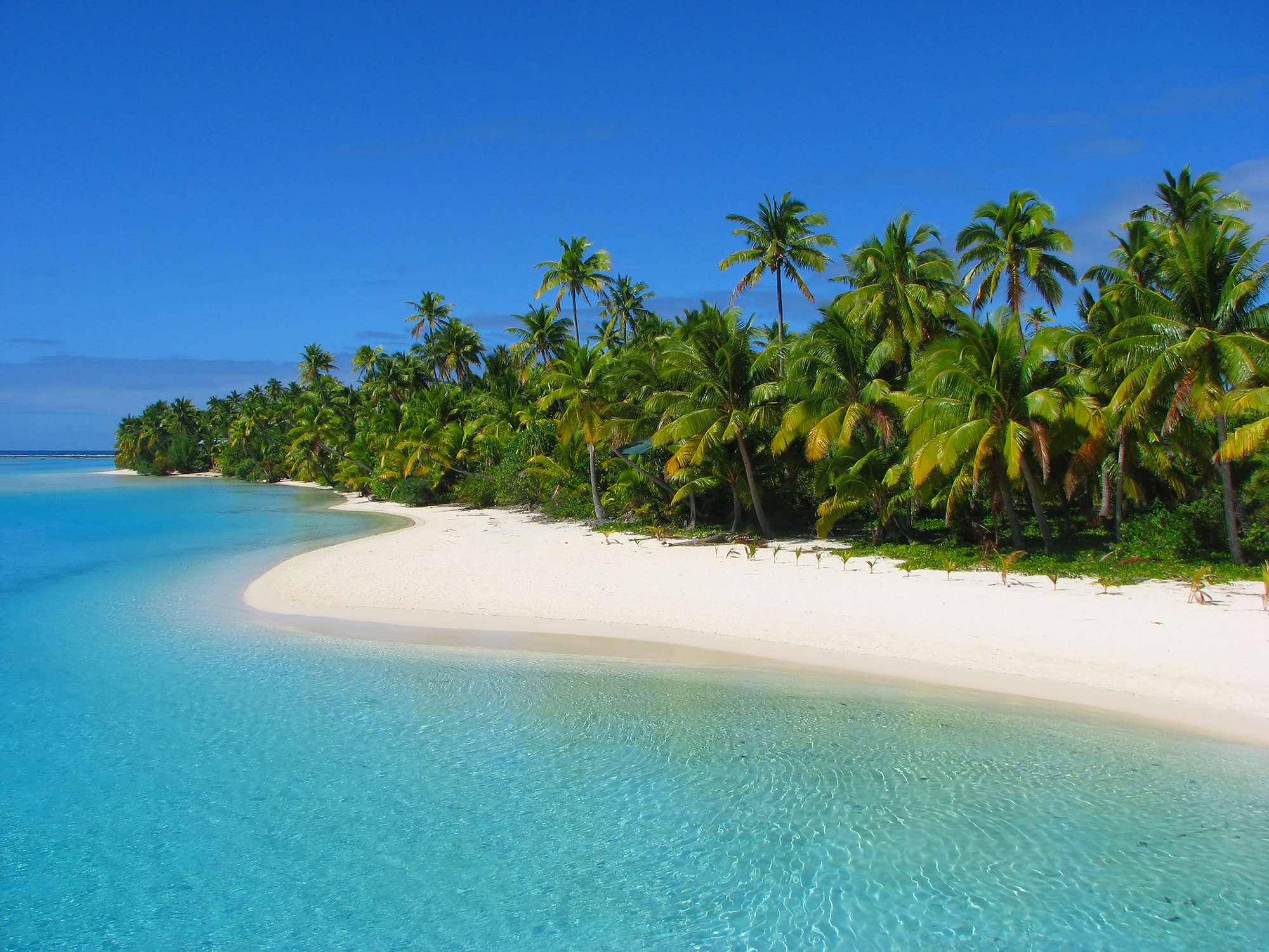
7. Cook Island Marine Reserve, Australia
Cook Island Marine Reserve is a small protected area not too far from the Gold Coast in southeast Queensland. This place is a sanctuary for marine life, inhabited by a wide variety of marine life, including parrotfish, pufferfish, groupers, leopard sharks, wobbegong and resident green sea turtles. The turtles can be spotted all year round.
When you interact with sea turtles, avoid touching them and keep a distance of 15 feet (4 to 5 meters). In this way, you can enjoy seeing the turtle and avoid disturbing this marine reptile.
Green and loggerhead turtles have both been recorded nesting on beaches in northern New South Wales with hatchlings emerging from nests from January to May. It’s worth noting, however, that Cook Island doesn’t have large turtle rookeries or the mass hatchings found at various sites in Queensland.
- Best time: May to October
- Nesting season: November to March
- Hatching season: January to May
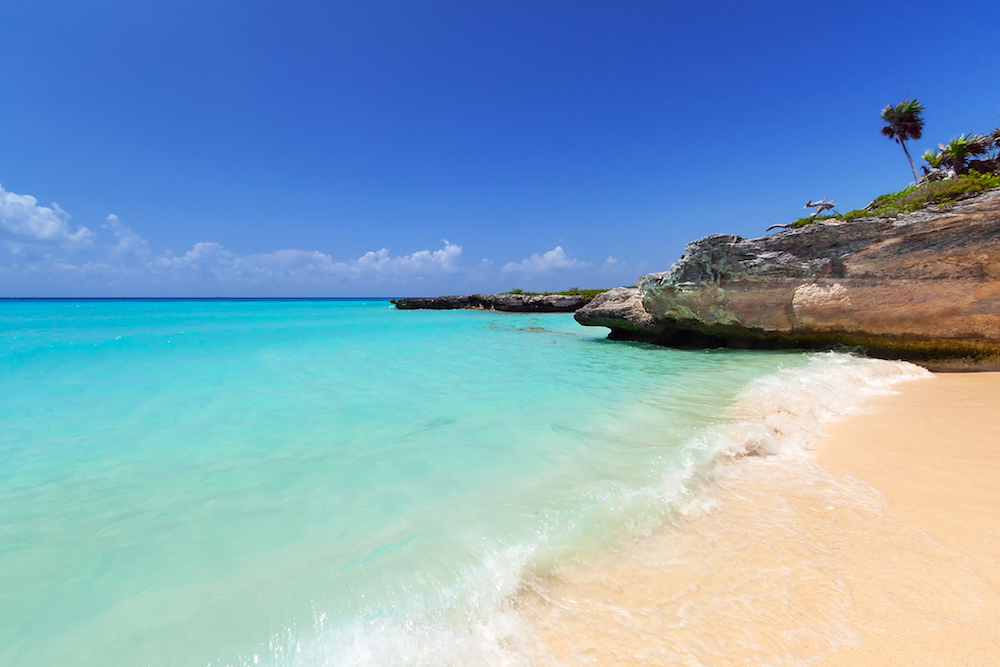
8. Akumal, Mexico
Located between Playa del Carmen and Tulum, Akumal is a Mayan word meaning “place of the turtle” and is the best place in Mexico to swim with green and loggerhead sea turtles.
Akumal Beach is ideal for snorkelers (even for beginners), because the small bay is protected by a reef and is shallow (15 feet / 5 meters in depth). The bed of the sea is sandy and covered by a carpet of plants that attract the turtles.
- Best time: May to August
- Nesting season: May to October (green turtles only)
- Hatching season: July to December
9. Tortuguero National Park, Costa Rica
If you are looking for two of the most spectacular wildlife events in the world (the nesting and hatching of sea turtles), you have to go to Tortuguero National Park on the northeastern coast of Costa Rica. This place is really rich in biodiversity. Here you’ll find mangroves, capuchin monkeys, hundreds of birds and, of course, sea turtles (green, hawksbill and leatherback), which can be spotted year round.
Green and leatherback sea turtles come to the beaches to lay their eggs. During the green turtle’s nesting season more than 2,000 females come to the area. Most of them lay eggs at night. So if you want to observe them, you’ll need a local guide, as it is forbidden to go on the beach after 6:00 pm.
The dry season is from November to April, but along the Caribbean coast you can experience tropical rain all year round.
- Best time: March to August
- Nesting season: July to October with the peak in August for green and hawksbill turtles; March to July for leatherback turtles
- Hatching season: September to December for green and hawksbill turtles; May to September for leatherback turtles
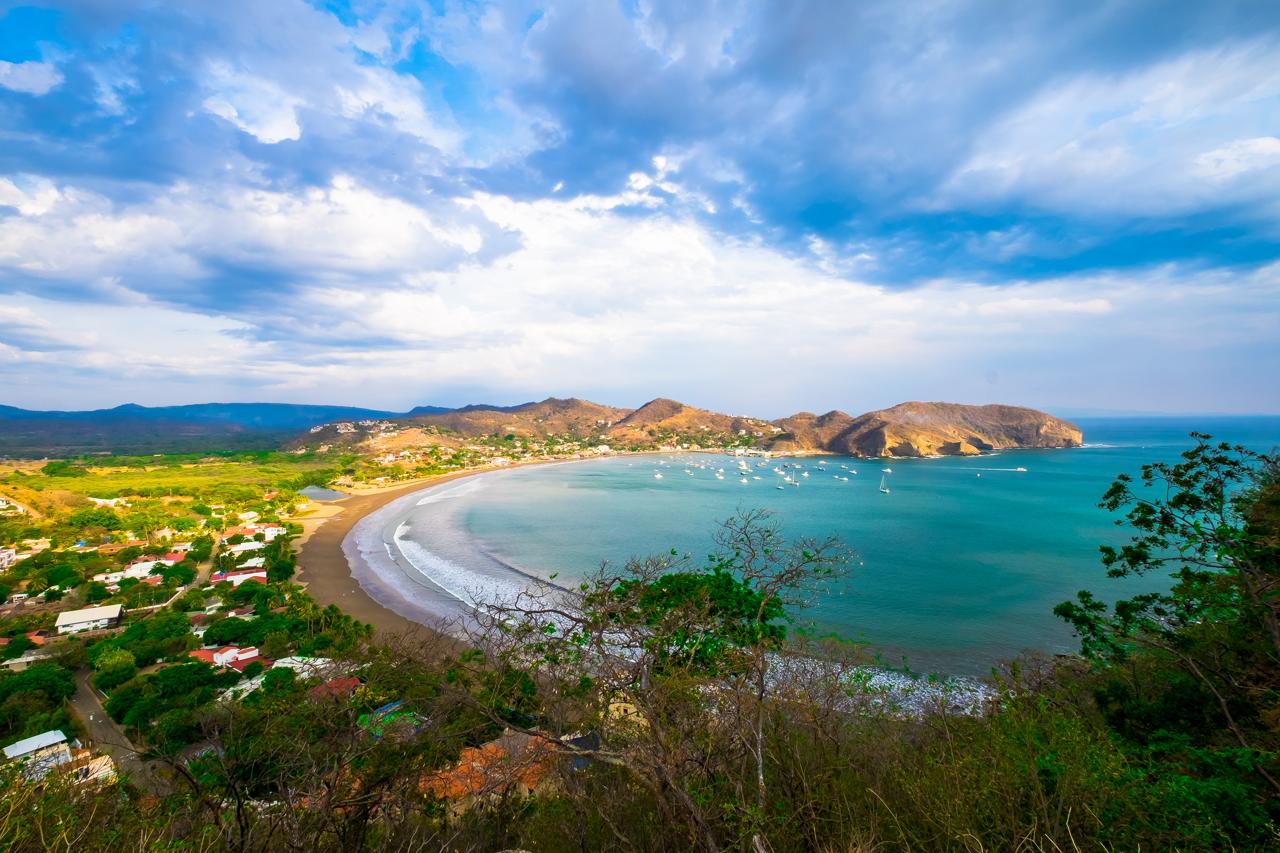
10. La Flor Wildlife Refuge, Nicaragua
Locally called Refugio De Vida Silvestre La Flor, this Nicaraguan wildlife refuge is one of the best places in the world to see thousands of female sea turtles coming to lay their eggs.
Located on the Pacific Coast of Nicaragua, close to San Juan del Sur and Costa Rica’s border, La Flor Wildlife Refuge hosts more than 100,000 olive ridley sea turtles from July to December. These turtles come to nest alongside the occasional hawksbill, leatherback and green sea turtle.
This phenomenon is locally called “arribada” and offers the opportunity to satisfy your sea turtle obsession.
Keep in mind that the wet season is from May to October, but as a tropical area, the temperature in Nicaragua is always between 23 and 32°C (73 and 90°F).
- Best time: July to November
- Nesting season: July to December
- Hatching season: September to February
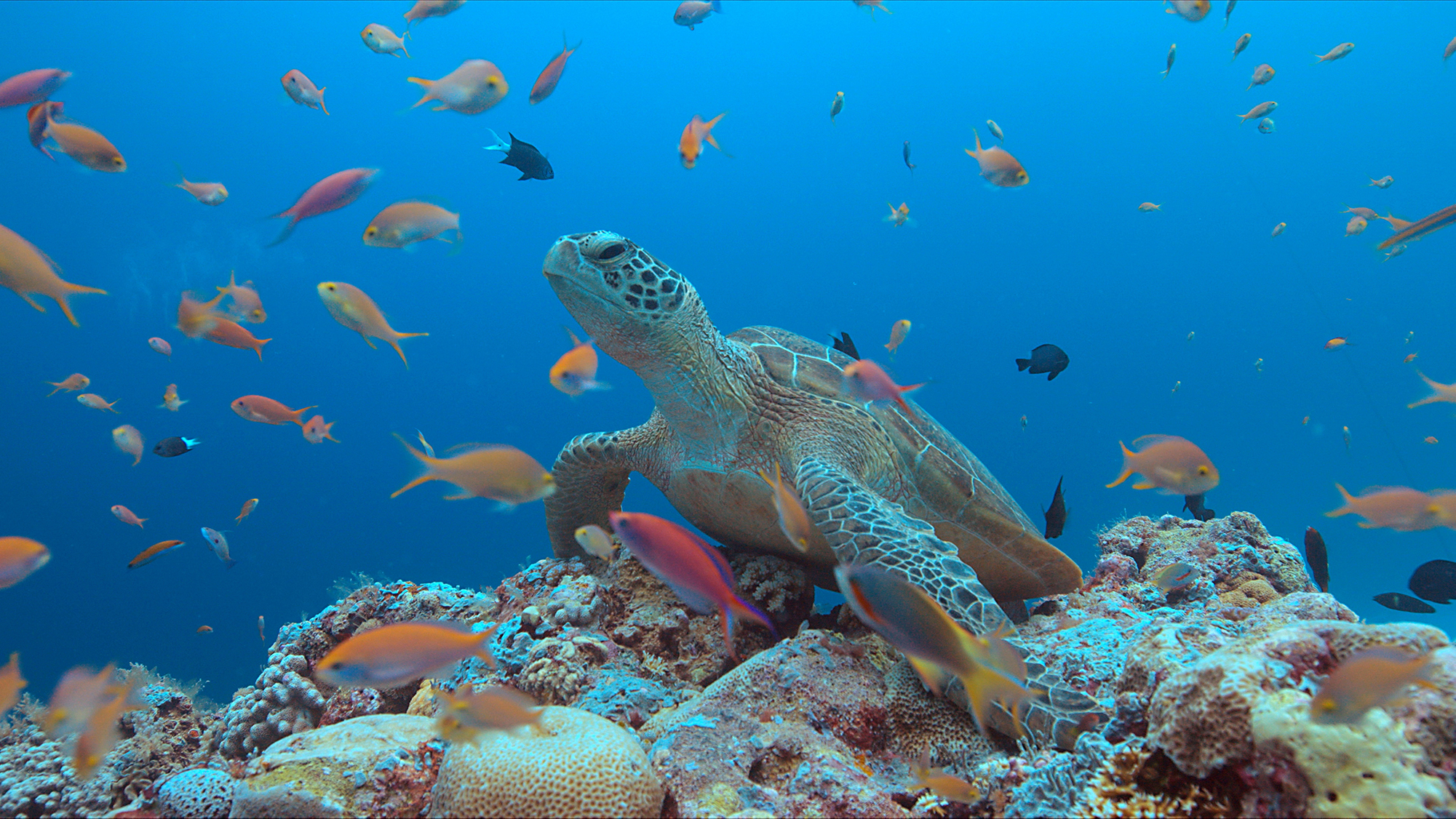
11. Bunaken Marine Park, Indonesia
Bunaken Marine Park is located in North Sulawesi in Indonesia. This was one of the first Marine Protected Areas created by the Indonesian Government – and it shows! Turtle numbers here are increasing year on year, and the park is thriving with kaleidoscopic coral reefs, schooling fish, critters, and passing pelagics.
The most commonly spotted species of turtle found in Bunaken is the green sea turtle, and at wall dive sites, such as Lekuan, it’s entirely possible to lose count of how many individuals you see during a single dive. Hawksbill turtles are also frequent sightings within the park.
Bunaken offers warm water, great visibility and easy conditions for all levels of divers all year round. The wettest months are from November to February.
- Best time: May to October
- Nesting season: April to September
- Hatching season: June to November

12. Baja California Sur, Mexico
The warm, nutrient-rich waters of Baja California Sur, Mexico attract various species of sea turtles, including the majestic loggerhead and the critically endangered hawksbill. As these ancient mariners embark on their epic migrations, they grace the coastlines of Baja California Sur, offering a captivating spectacle for those fortunate enough to encounter them.
Protected areas and marine reserves dot the region, providing a safe sanctuary for these magnificent creatures. Cabo Pulmo National Park, a UNESCO World Heritage Site, stands as a shining example of successful conservation efforts. Here, sea turtles find refuge amidst coral reefs, creating an underwater paradise for snorkelers and divers seeking a close encounter with these gentle giants.
Whether snorkeling through crystal-clear waters or diving amidst thriving coral reefs, this magical destination offers a unique opportunity to witness these ancient mariners in their natural habitat.
- Best time: May to December
- Nesting season: June to December
- Hatching season: August to January
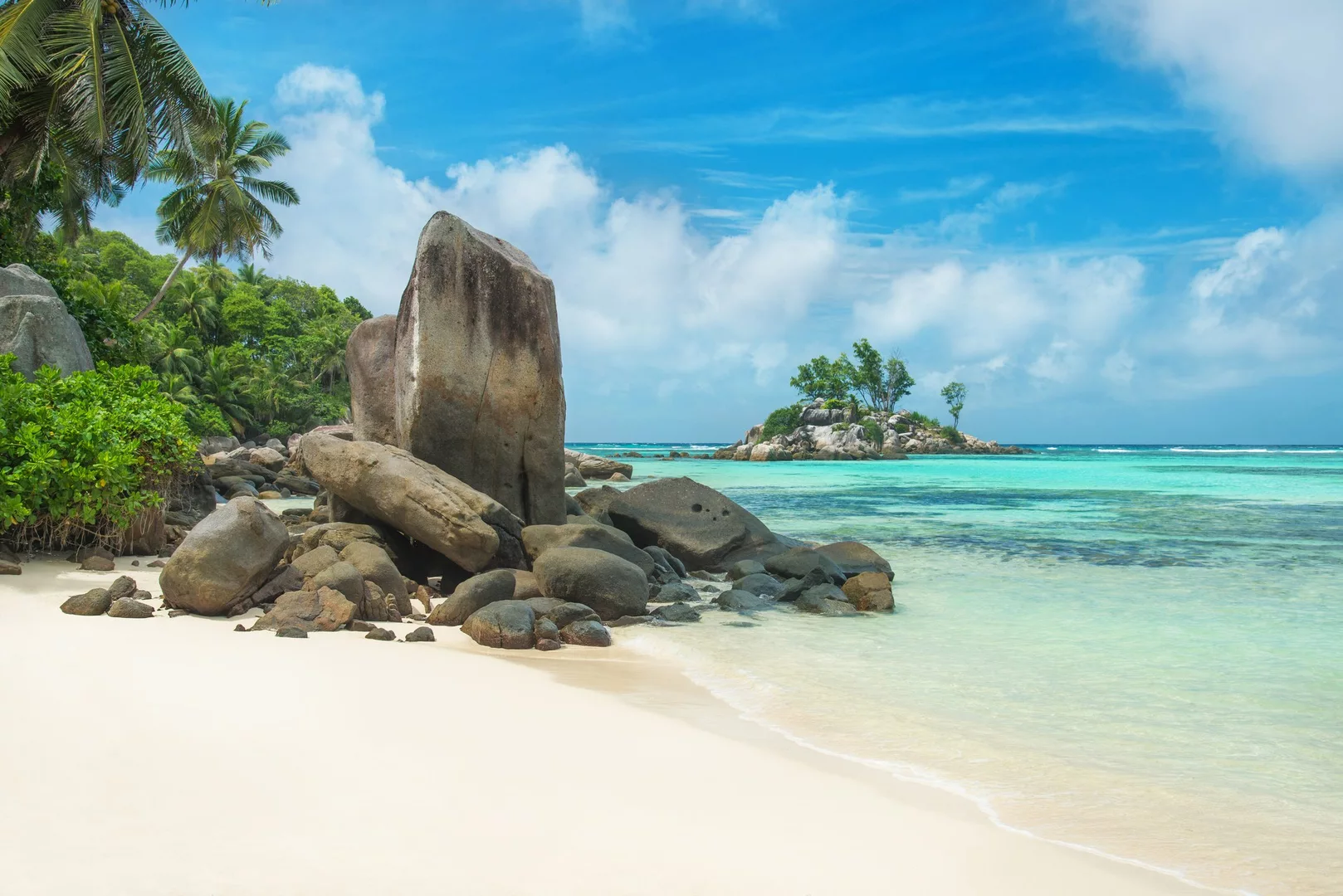
13. The Seychelles
One of the main reasons the Seychelles captivates sea turtle enthusiasts is its rich population of green and hawksbill turtles. These beautiful species call the Seychelles home, finding solace in its protected marine parks and abundant seagrass meadows. Whether you choose to snorkel or dive, you’ll have the privilege of encountering these majestic creatures in their natural habitat.
The Aldabra Atoll, a UNESCO World Heritage Site and one of the world’s largest coral atolls, stands as a crown jewel of the Seychelles’ sea turtle conservation efforts. Its pristine waters are teeming with green turtles, creating amazing opportunities for encounters.
Timing your visit to the Seychelles is also key to optimizing your sea turtle encounters. The nesting seasons of green and hawksbill turtles occur between October and January, when females return to the beaches to lay their eggs. Witnessing this awe-inspiring event is a once-in-a-lifetime experience.
- Best time: October to January
- Nesting season: October to January
- Hatching season: November to April
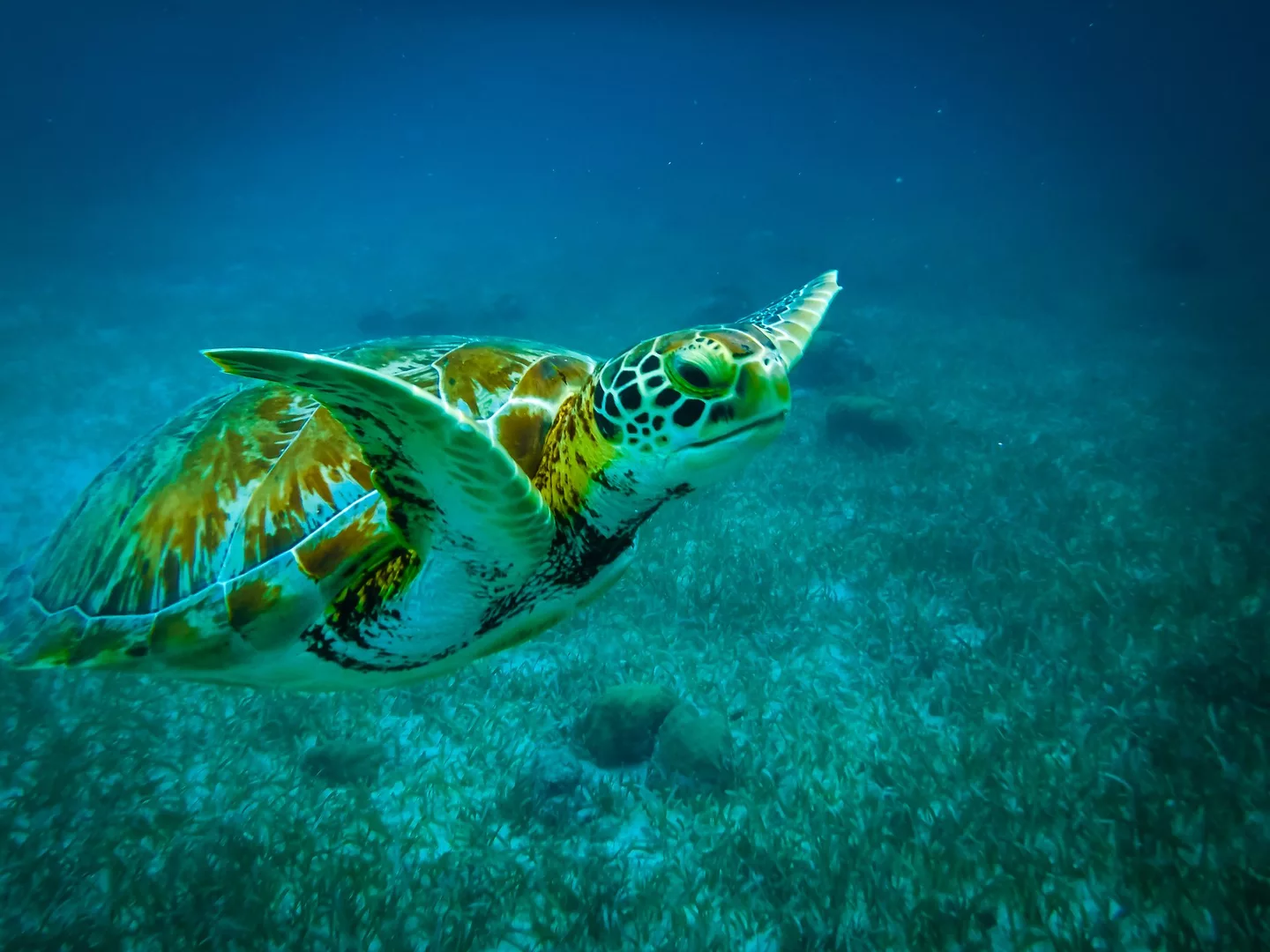
14. Ambergris Caye, Belize
As home to the world’s second-largest barrier reef, it’s little wonder that Belize offers a fantastic chance for visitors to encounter sea turtles up close.
Of its numerous turtle-filled sites, Belize’s Hol Chan Marine Reserve may be the best. Located at the southern end of Ambergris Caye, this idyllic spot has all the right ingredients for a turtle-y awesome time. The nearby nesting beaches (on Ambergris Caye), colorful, healthy coral reefs, and plentiful seagrass make underwater encounters with turtles a common occurrence. Whether you’re snorkeling or diving, you’ve got a great chance of meeting green or hawksbill turtles, with some lucky visitors even getting to see the less common loggerheads.
Additionally, thanks to the reserve’s pristine underwater habitats, visitors can also look forward to a range of other wildlife sightings. From hundreds of fish species and dolphins to nurse sharks and even manatees, there’s no shortage of memorable moments to be had below the surface.
- Best time: January to May
- Nesting season: May to August
- Hatching season: July to November
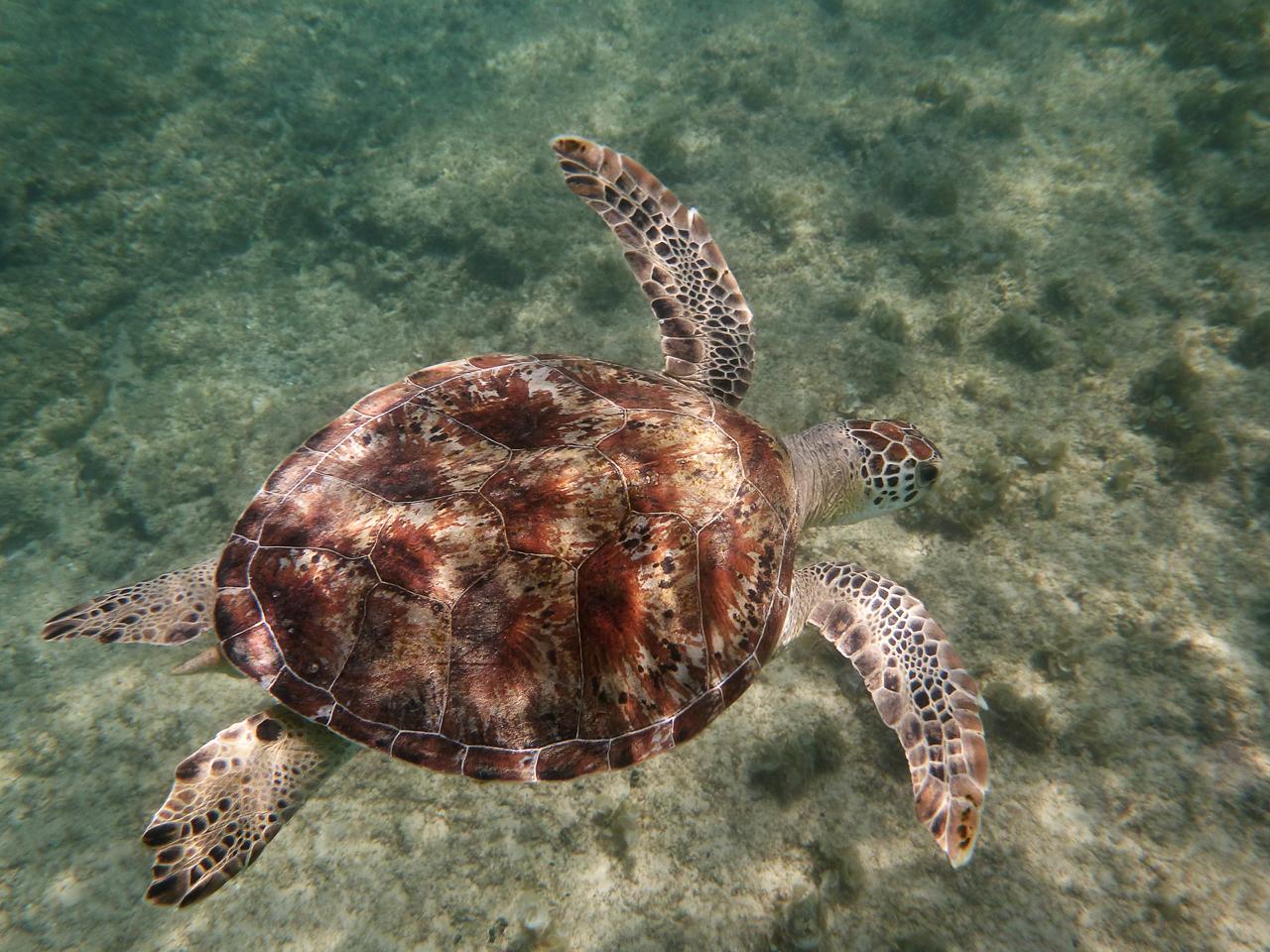
15. Fujairah, United Arab Emirates
With its calm waters and healthy coral reefs, coastal Fujairah is one of the best places to snorkel with turtles in the Middle East. The city is situated on the eastern coast of the United Arab Emirates and offers easy access to the Gulf of Oman. Here, visitors can take to the water for the chance to encounter one of the four turtle species found in the area.
Beneath the surface, seagrass beds and healthy coral reefs, teeming with sponges, provide an abundant food source for these turtles. This underwater buffet alongside the miles of nesting-ready sandy beach is one of the major reasons that turtle encounters are so common.
Snoopy Island, a popular snorkeling spot just north of Fujairah, is another excellent turtle destination. It’s easily accessible from the city, and you can even visit as a day trip from Dubai. Here, green and hawksbill turtles are regularly seen, alongside other marine life, such as fish, sharks, cuttlefish and rays.
- Best time: October to May
- Nesting season: March to July
- Hatching season: May to August
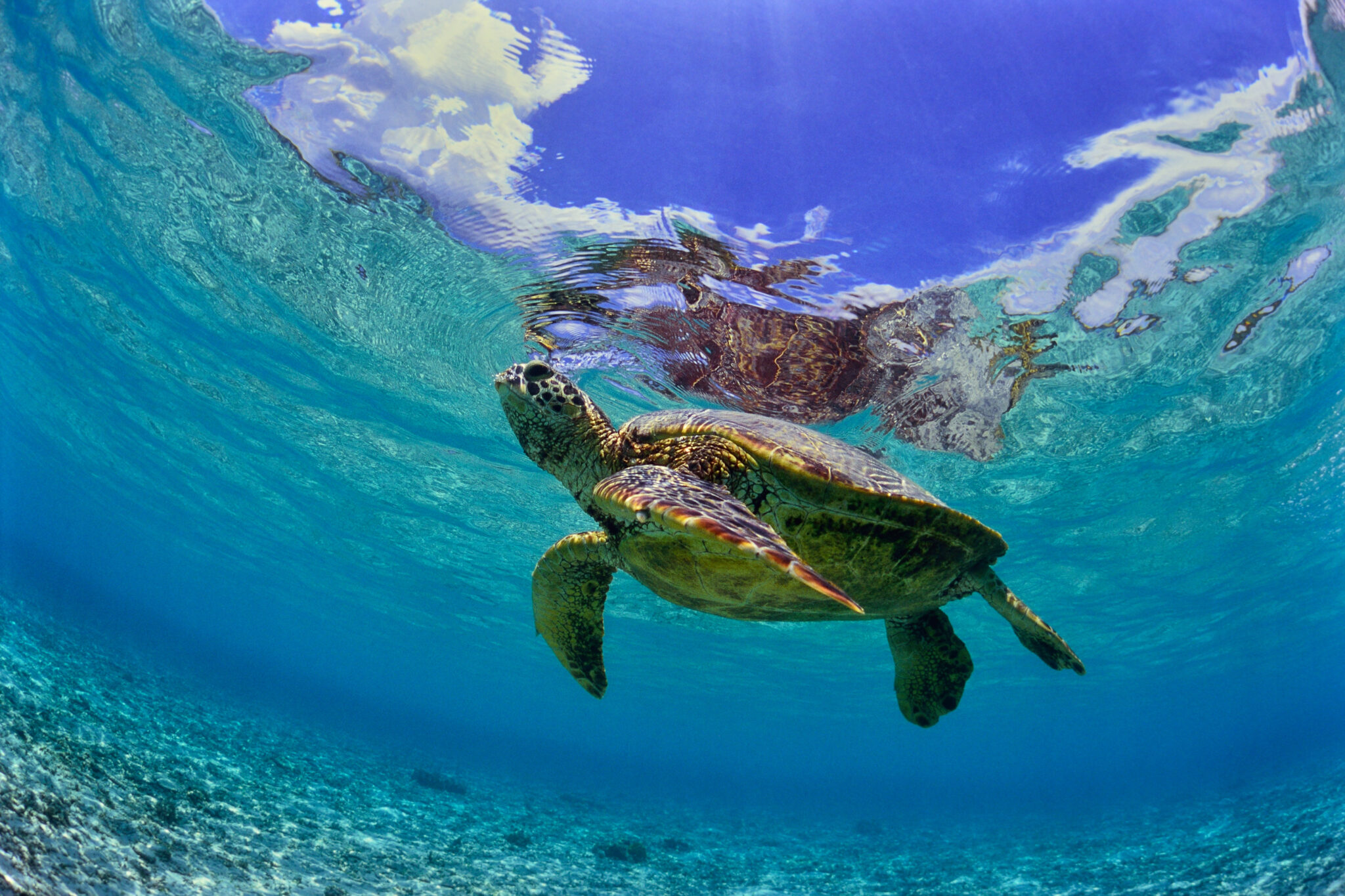
16. Kerama Islands, Okinawa, Japan
Few places are as picturesque as Okinawa in Japan. To make this destination even better, it’s one of the best places to swim with sea turtles. The island’s turquoise blue backdrop will long sit in your memory as you watch these marine reptiles gliding through the crystal-clear water.
The Kerama Islands, which are a short journey from the south western coast of Okinawa Island, are one of the top diving destinations in Japan. Alongside their beautifully clear water, these idyllic islands provide ideal nesting habitat for sea turtles. Hawksbill, green, and loggerhead turtles are all commonly encountered here, and olive ridley turtles can also occasionally (but rarely) be seen.
What makes the Kerama Islands a truly top destination is the variety of marine life on show. In addition to turtles, snorkelers and divers may see reef sharks, eagle rays, barracuda, giant trevally, moray eels, lionfish, octopuses, a range of nudibranchs and more. And, during the right time of year, Okinawa is a great place to get in the water with humpback whales.
- Best time: May to October
- Nesting season: May to September
- Hatching season: July to October
How to Approach Sea Turtles
Sea turtles are animals that tend to be indifferent to our presence. All of us, from beginners to expert divers, are attracted by their presence and we often approach them to admire or take footage of them.
Find out how to interact without disturbing them below.
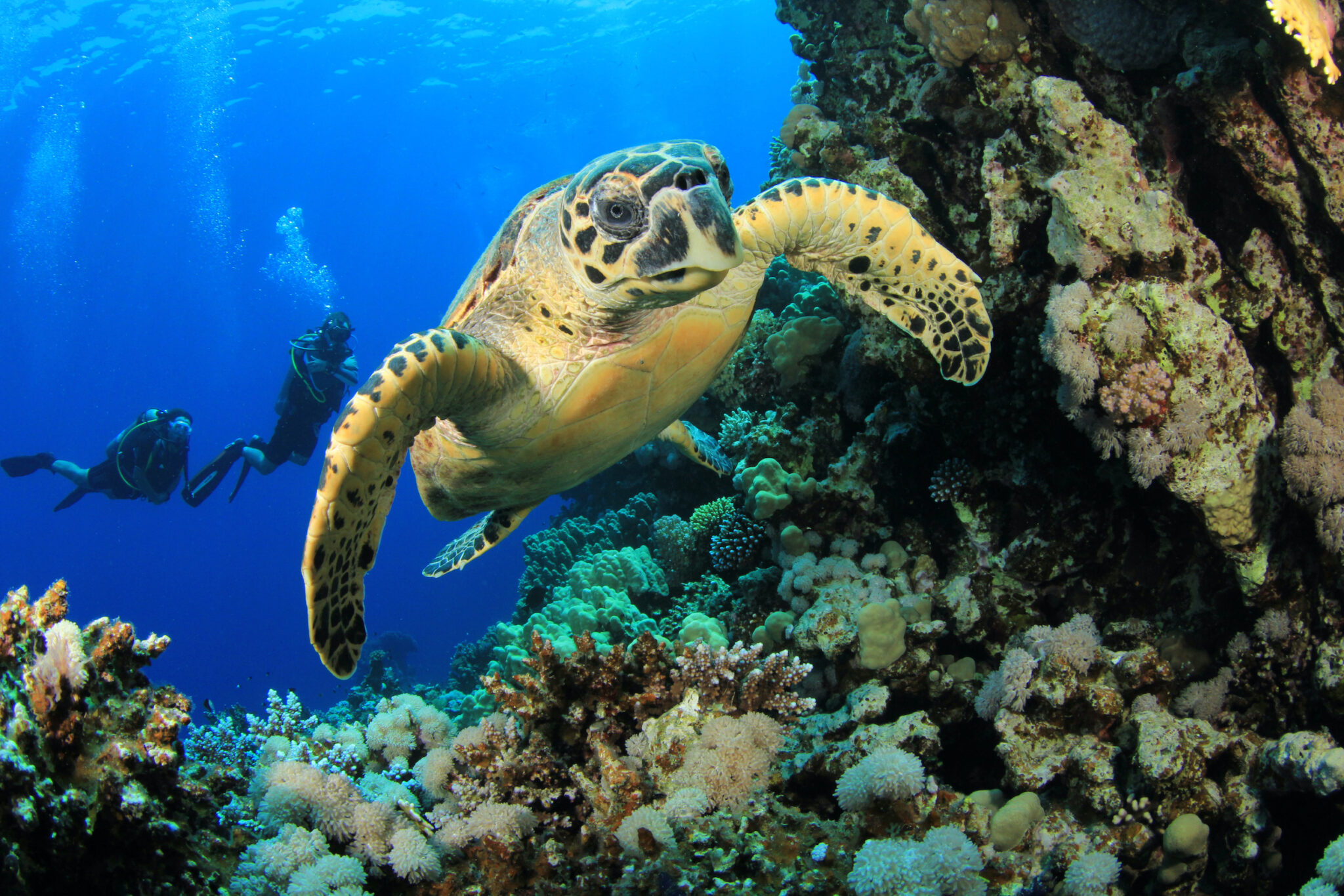
Swimming and Diving With Turtles
Contrary to what you might think, the carapace (commonly called the shell), plastron and skull of these reptiles is very sensitive. For this reason, you should never touch a sea turtle.
Touching can frighten the animals and prolong their apnea (breath holding), causing severe lung damage in the worst cases. Always remain at a distance from sea turtles and do not hinder their swimming. By keeping a respectful distance and following responsible diving and snorkeling practices, we can contribute to the conservation and well-being of sea turtles. Admiring these magnificent creatures from a distance allows them to thrive in their natural habitats while ensuring that future generations can continue to enjoy and appreciate their presence.
Sea Turtles Nesting
During the deposition of eggs, do not point any lights or camera flashes at the female, especially in the phase preceding the deposition itself. Light may cause the turtle to stop laying eggs and leave. If you are lucky enough to observe this behavior, keep a distance and be as quiet as possible.
Should you be the lone spectator of this event, remember to report the nest to the appropriate authorities. This way the turtles’ eggs can be protected.
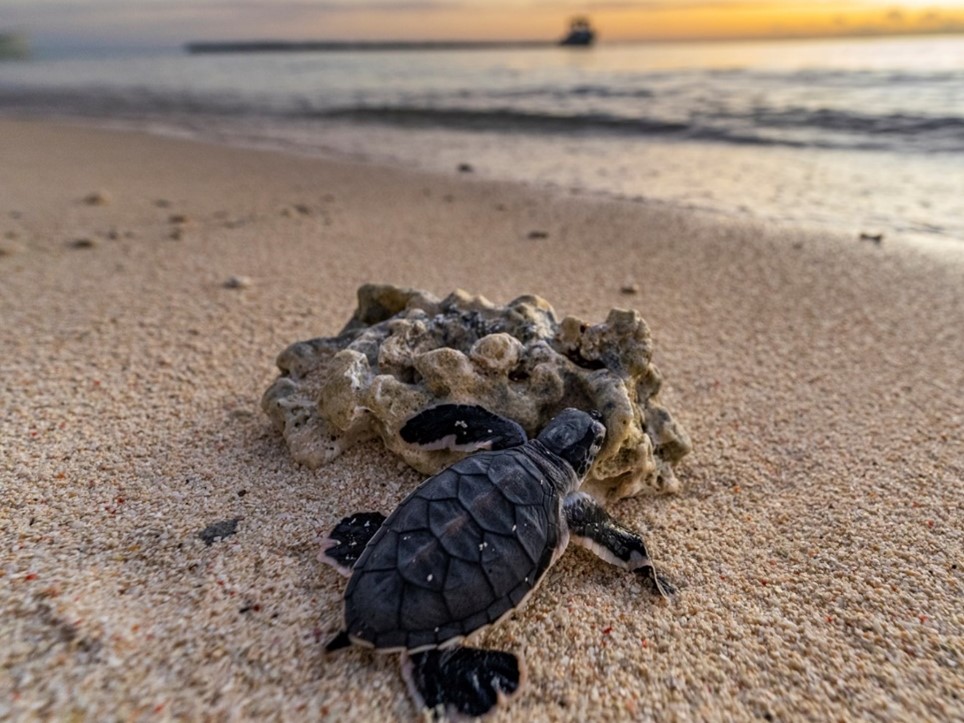
Egg Hatching
When the eggs hatch and the newborns are emerging from the sand, avoid touching them. Instead, passively observe the event and do not block their path to the sea. It is important for the hatchlings to enter the water quickly and avoid being intercepted by predators on the beach.
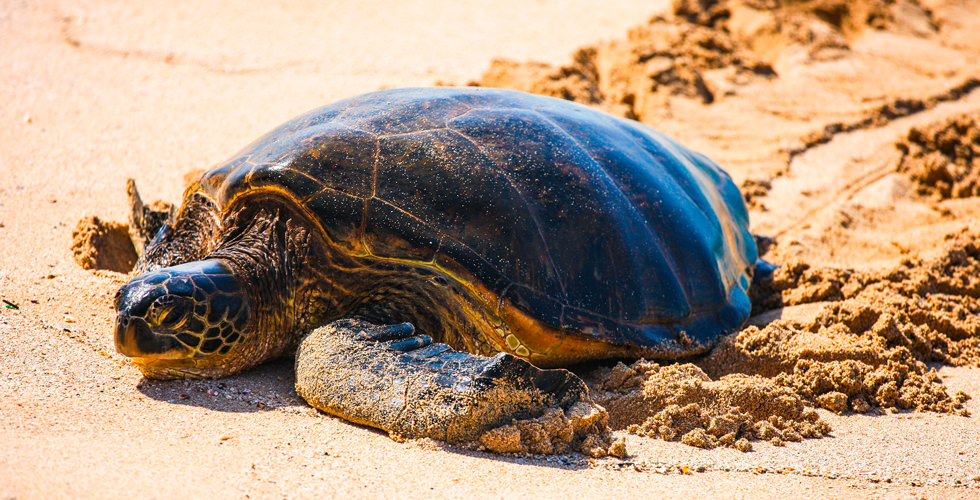
Photographing Sea Turtles
Avoid excessive flash photography when photographing sea turtles. Flash photography can startle and stress sea turtles, disrupt their natural behaviors, and potentially affect their survival. The sudden bursts of light can temporarily blind or disorient them, impairing their ability to navigate and increasing their vulnerability to predators. Additionally, flash photography during nesting and hatching seasons can disturb the nesting process and disorient hatchlings, jeopardizing their successful journey to the ocean. Respecting their natural environment and refraining from using flash ensures the well-being and conservation of these magnificent creatures.
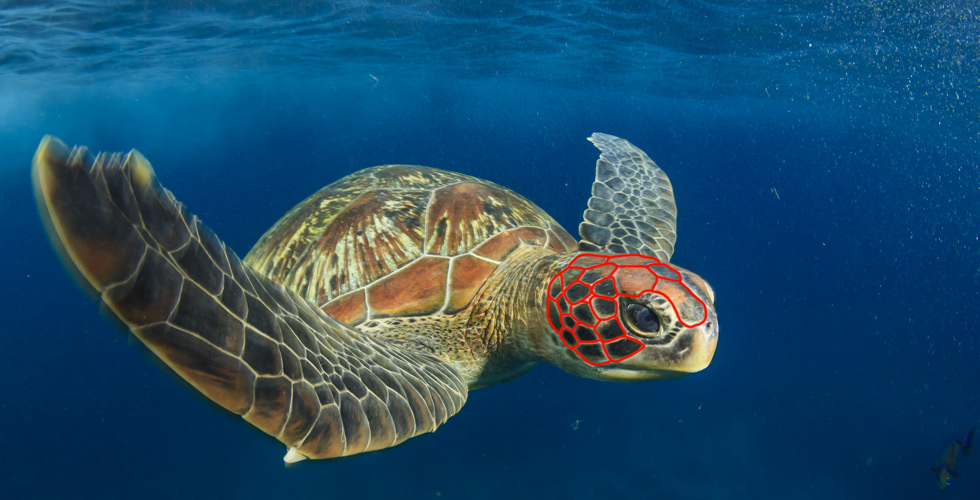
ID-ing Sea Turtles
Identifying sea turtles is very important for researchers in order to monitor the populations of species around the world. Be an Ocean Torchbearer, and take photographs of both sides of the head and full body of any sea turtle you encounter in the water. The heads of sea turtles have dark scales (facial scutes) that are unique to each individual, just like our fingerprints.
Photographs of the full body allow you to see if the turtle is female or male. Males have long tails, whereas females and juveniles have short tails that are often invisible.
Send this material plus the date and location of the sighting to one of the associations listed at the end of the article. They will identify the animal and send some info about it to you. If it’s a new individual, you might even get to name it!

Sea Turtles & Predators
The natural predators of juvenile sea turtles are numerous. Even while sea turtles are still in their eggs, crabs enjoy digging in with their claws.
Perhaps the most dangerous time in a young turtle’s life is when it must make the dash from nest to sea. During this stage, baby turtles can be eaten by crabs, birds, dogs, foxes and other animals. Once they arrive in the water, fish also become predators. It’s estimated that only 1 in every 1,000 baby sea turtles becomes an adult.
One way to help prevent the death of baby sea turtles is to take caution when visiting nesting beaches with pets. Always have your animals on a leash and keep an eye on what your pet is playing with.
In adulthood, the number of predators decreases dramatically. At this stage, sharks and killer whales are the only animals (other than humans) that are dangerous to sea turtles.
Threats to Sea Turtles
Human activities pose the most significant threat to sea turtles. These activities include, but are not limited to:
- Entanglement in fishing gear: Fishing nets can become a deadly trap for these reptiles. Because they can no longer breathe on the surface, they die by drowning. Fishing hooks can also hurt and kill sea turtles.
- Poaching and illegal trade of eggs, meat and shells: These practices are reducing the number of adults and newborns, hindering the development of new generations.
- Ocean pollution, plastic and marine debris: When ingested, these pieces of garbage can lead to death. Moreover, pollution can kill or damage their natural food.
- Coastal development: New construction on the coast can destroy or reduce natural nesting areas, impeding the deposition of the eggs.
- Global warming: This global phenomenon is altering marine ecosystems, crippling a natural balance that has existed for millions of years.
All of these activities are bringing sea turtles closer to extinction.
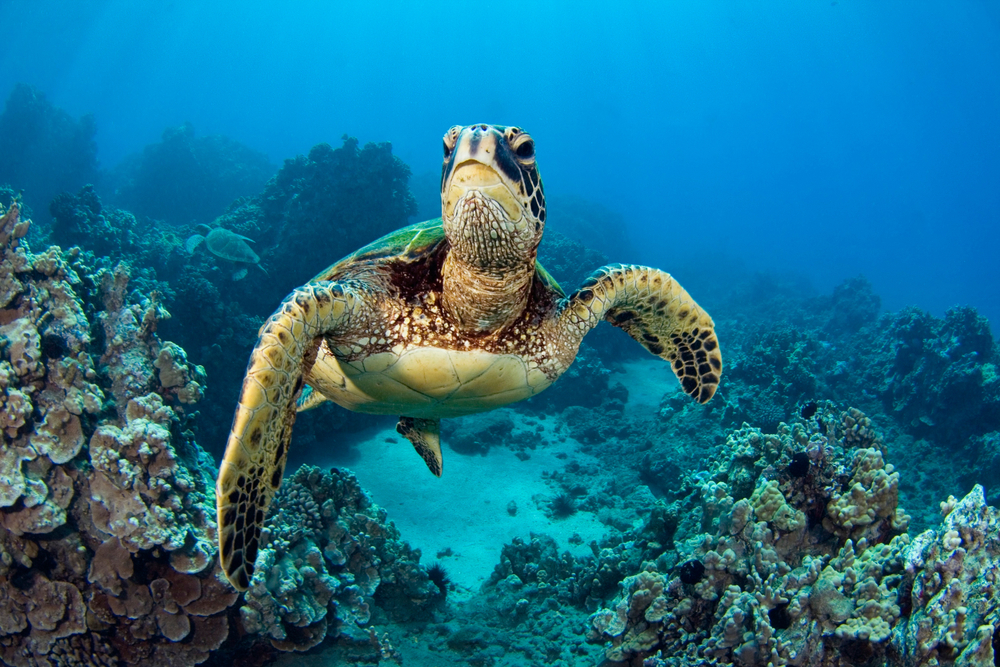
Common Questions About Sea Turtles
Want to learn more about these fascinating marine reptiles? Here are the answers to some of the most frequently asked questions about sea turtles.
How Long Do Sea Turtles Live?
The average lifespan of a sea turtle is between 50 and 100 years. However, different sea turtle species have different estimated lifespans.
How Many Species of Sea Turtle Are There?
There are seven species of sea turtle. These are:
- Green Sea Turtle (Chelonia mydas)
- Leatherback Turtle (Dermochelys coriacea)
- Loggerhead Turtle (Caretta caretta)
- Olive Ridley Turtle (Lepidochelys olivacea)
- Kemp’s Ridley Turtle (Lepidochelys kempii)
- Hawksbill Turtle (Eretmochelys imbricata)
- Flatback Turtle (Natator depressus)
How Do Sea Turtles Sleep?
Because sea turtles need to breathe air, they cannot remain under water indefinitely. However, thanks to their ability to hold their breath for several hours at a time, sea turtles are capable of sleeping while floating at the surface or underwater on the sea floor.
Are Sea Turtles Endangered?
Of the seven sea turtle species, one is currently classed as endangered (green), three are vulnerable (leatherback, loggerhead and olive ridley), two are critically endangered (Kemp’s ridley and hawksbill) and the data for the flatback sea turtle is deficient.
What Do Sea Turtles Eat?
Different sea turtle species have different diets. For example, a green sea turtle diet includes seagrasses, algae and seaweed. Leatherback sea turtles eat jellyfish and other soft-bodied invertebrates. Hawksbill sea turtles mostly eat sponges, and the remaining sea turtle species enjoy more varied diets.

Sea Turtle Saviors
Fortunately, there are several groups of experts who have founded associations that work to protect sea turtles through research, education, training, and habitat protection.
For further information take a look at: HEPCA, Sea Turtle Conservancy, Olive Ridley Project, See Turtles, Sea Turtle Inc., Sea Turtle Preservation Society and The Leatherback Trust.
Overall, there has been a steady decline in worldwide sea turtle populations, but there are ways to fight this. Learn basic sea turtle identification, how to record sightings and conservation steps you can take with the PADI Sea Turtle Awareness Specialty Course. Not every PADI Dive Shop offers this course, so be sure to use our locator below to help you find one that does!
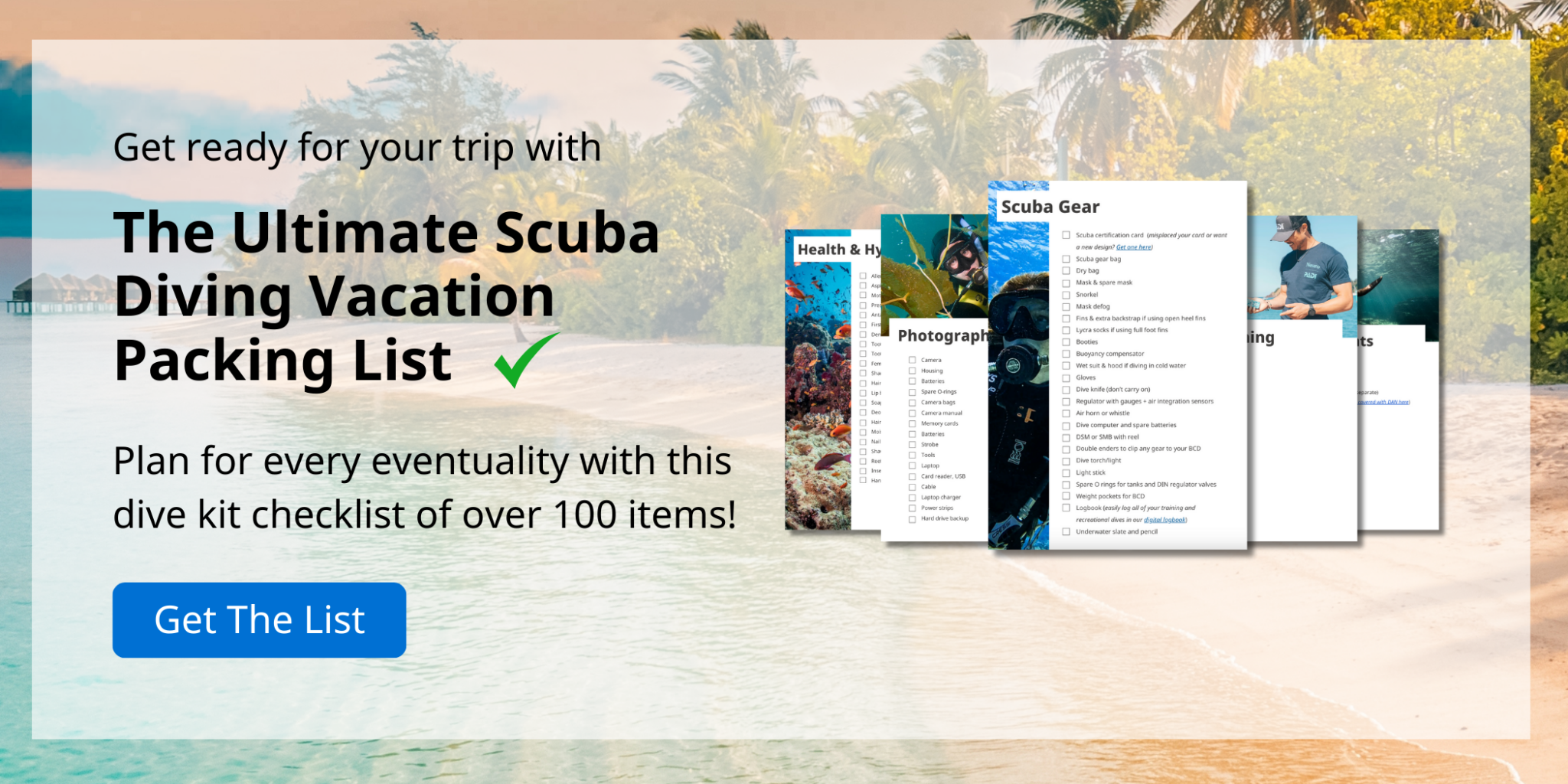
Credit
Special thanks to Mario Passoni for writing this article, as well as to Agnese Mancini from HEPCA, Christian Díaz Chuquisengo from The Leatherback Trust and Alessandra Sulis.
